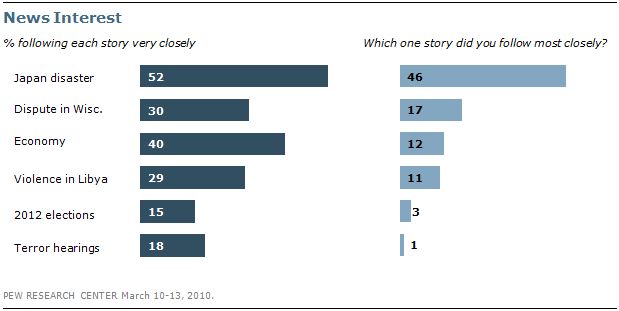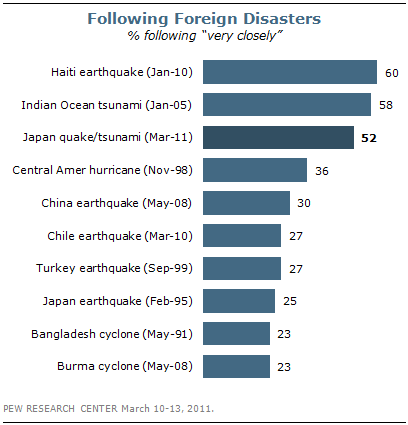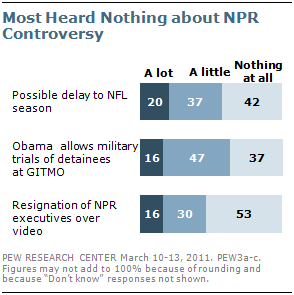Summary of Findings
The devastating earthquake and tsunami that hit Japan late last week dominated the public’s news interest – and news media coverage – in the days following the March 11 disaster.
Roughly half (52%) of the public say they very closely followed news about the massive earthquake off the northeast coast of Japan and the tsunami that followed, according to the latest News Interest Index survey, conducted March 10-13 among 1,001 adults. The Japan disaster was by far the top story of the week – 46% say this was the news they followed most closely last week; no other story came close.

 Still, the number who say they followed the Japanese catastrophe very closely is
Still, the number who say they followed the Japanese catastrophe very closely is
somewhat less than the 60% that said they followed news that closely about the earthquake that devastated Haiti in January 2010. In January 2005, 58% said they very closely followed news about the major earthquake and tsunami that struck Indonesia, Sri Lanka and other south Asian nations. Later that year, more Americans paid very close attention to a disaster in this country – Hurricane Katrina – the week that hurricane hit the Gulf Coast (70% very closely).
For its part, the media devoted more than half (52%) of news coverage on Friday – the day the earthquake and tsunami hit – to the disaster in Japan, according to a separate analysis by the Pew Research Center’s Project for Excellence in Journalism (PEJ). For the full week, the late-breaking story accounted for 12% of coverage.
Prior to Friday, two ongoing stories – the fighting in Libya and the confrontation over public employee bargaining rights in Wisconsin – had dominated news coverage. By week’s end, news organizations had shifted focus to the devastation in Japan, rescue efforts and threat of a major nuclear accident at a heavily damaged nuclear power complex. Those story lines continue to drive extensive coverage this week.
Looking at the week’s other top stories, 30% say they very closely followed news about the disputes in Wisconsin and other states between state governments and public employee unions. Fully 17% say this was the news they followed most closely. News about the disputes, which reached a critical juncture last week when Wisconsin Republicans passed a measure scaling back public employee bargaining rights, accounted for 13% of the full week’s newshole, according to PEJ.
Four-in-ten (40%) say they very closely followed news about the condition of the U.S. economy. This was the top story for 12%. General economic news – apart from the state budget fights – accounted for 6% of coverage for the week.
About three-in-ten (29%) say they followed news about the violence in Libya very closely; 11% say this was the news they followed most closely. News about the fighting in Libya accounted for 19% of coverage, most of the 21% devoted to Middle East unrest more generally.
The public continued to show modest interest in news about possible candidates for the 2012 presidential elections; 15% say they followed developments about potential candidates very closely, essentially unchanged from the 16% that said this in mid-February. Just 3% say news about potential candidates was the story they followed most closely. News about possible 2012 presidential candidates accounted for 1% of the newshole.
Nearly two-in-ten (18%) say they very closely tracked news about the contentious House hearing held last week on possible support for terrorism among Muslim Americans; 1% say this was the story they followed most closely. News about the hearing accounted for 5% of coverage last week.
Most Aware of Guantanamo Decision, NFL News
 Most Americans say they heard at least a little last week about President Obama’s decision to allow military trials of detainees at the Guantanamo Bay prison (63%) and the possibility that the National Football League season will be delayed or cancelled because of a labor dispute (57%). Fewer say they heard about the resignation of NPR executives after the release of a video secretly made by conservative activists: 46% percent had heard at least a little about this, while a majority – 53% – had heard nothing at all.
Most Americans say they heard at least a little last week about President Obama’s decision to allow military trials of detainees at the Guantanamo Bay prison (63%) and the possibility that the National Football League season will be delayed or cancelled because of a labor dispute (57%). Fewer say they heard about the resignation of NPR executives after the release of a video secretly made by conservative activists: 46% percent had heard at least a little about this, while a majority – 53% – had heard nothing at all.
Just 16% say they heard a lot about the NPR resignations, while 30% heard a little about this story. There were no partisan differences in how likely people were to have heard a
lot about the secretly-recorded NPR video. Democrats, however, were slightly more likely than Republicans to have heard nothing at all about this (58% versus 47%).
Another 16% say they heard a lot about President Obama’s decision to resume military trials at Guantanamo Bay. Almost half of the public (47%) say they had heard a little about this story, while 37% had heard nothing at all.
One-in-five (20%) say they heard a lot about a possible delay or cancellation of the upcoming NFL season because of a labor dispute; 37% had heard a little and 42% had heard nothing at all about this story.
Men – particularly young men – heard more about the NFL developments. A quarter of men (25%) had heard a lot about this topic, compared with 16% of women. Three-in-ten (30%) men younger than 50 say they heard a lot about the NFL situation; that compares with 17% of women 18 to 49 and 20% of men 50 and older.
These findings are based on the most recent installment of the weekly News Interest Index, an ongoing project of the Pew Research Center for the People & the Press. The index, building on the Center’s longstanding research into public attentiveness to major news stories, examines news interest as it relates to the news media’s coverage. The weekly survey is conducted in conjunction with The Project for Excellence in Journalism’s News Coverage Index, which monitors the news reported by major newspaper, television, radio and online news outlets on an ongoing basis. In the most recent week, data relating to news coverage were collected March 7-13, and survey data measuring public interest in the top news stories of the week were collected March 10-13, from a nationally representative sample of 1,001 adults.
About the Survey
The analysis in this report is based on telephone interviews conducted March 10-13, 2011 among a national sample of 1,001 adults 18 years of age or older living in the continental United States (670 respondents were interviewed on a landline telephone, and 331 were interviewed on a cell phone, including 154 who had no landline telephone). The survey was conducted by interviewers at Princeton Data Source under the direction of Princeton Survey Research Associates International. A combination of landline and cell phone random digit dial samples were used; both samples were provided by Survey Sampling International. Interviews were conducted in English. Respondents in the landline sample were selected by randomly asking for the youngest adult male or female who is now at home. Interviews in the cell sample were conducted with the person who answered the phone, if that person was an adult 18 years of age or older. For detailed information about our survey methodology, see: https://legacy.pewresearch.org/politics/methodology/detailed.
The combined landline and cell phone sample are weighted using an iterative technique that matches gender, age, education, race, Hispanic origin, region, and population density to parameters from the March 2010 Census Bureau’s Current Population Survey. The sample also is weighted to match current patterns of telephone status and relative usage of landline and cell phones (for those with both), based on extrapolations from the 2010 National Health Interview Survey. The weighting procedure also accounts for the fact that respondents with both landline and cell phones have a greater probability of being included in the combined sample and adjusts for household size within the landline sample. Sampling errors and statistical tests of significance take into account the effect of weighting. The following table shows the sample sizes and the error attributable to sampling that would be expected at the 95% level of confidence for different groups in the survey:

Sample sizes and sampling errors for other subgroups are available upon request.
In addition to sampling error, one should bear in mind that question wording and practical difficulties in conducting surveys can introduce error or bias into the findings of opinion polls.


